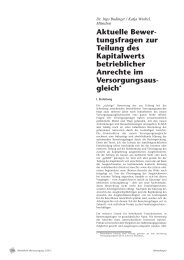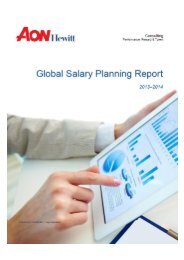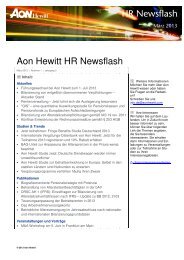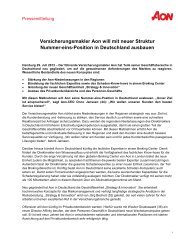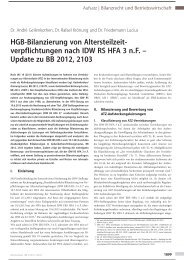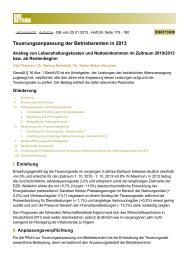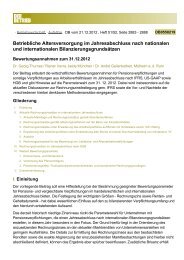Managing your Frozen Pension Plan: A New Paradigm - Aon
Managing your Frozen Pension Plan: A New Paradigm - Aon
Managing your Frozen Pension Plan: A New Paradigm - Aon
Create successful ePaper yourself
Turn your PDF publications into a flip-book with our unique Google optimized e-Paper software.
v<br />
<strong>Managing</strong> <strong>your</strong> <strong>Frozen</strong> <strong>Pension</strong><br />
<strong>Plan</strong>: A <strong>New</strong> <strong>Paradigm</strong>
<strong>Managing</strong> <strong>your</strong> <strong>Frozen</strong> <strong>Pension</strong> <strong>Plan</strong>: A <strong>New</strong> <strong>Paradigm</strong><br />
Recent changes in funding requirements and financial reporting have brought increased attention to frozen<br />
pension plans. Coupled with recent market turmoil, there is increased interest in finding better ways to move<br />
these single employer and multiple employer qualified plans to full funding.<br />
<strong>Managing</strong> the <strong>Frozen</strong> <strong>Pension</strong> <strong>Plan</strong> as a Financial Obligation<br />
When a pension plan is frozen, the future growth of the plan’s benefits stops. However, the plan sponsor must<br />
still fulfill the commitment for the benefits already promised. This is accomplished by (1) moving the plan to a<br />
fully funded status and (2) deciding how to execute the benefit commitments that may extend beyond the life<br />
of the organization. The frozen pension plan is no longer a human resource tool, but a financial obligation<br />
which must be aggressively addressed to insure that:<br />
• participant benefits will be paid in full, which is in the best interest of all concerned: plan participants, the<br />
employer, the PBGC, and the country.<br />
• the cost to the sponsor is minimized, which is in the interest of current employees and the sponsor as it<br />
provides more funds for other enhanced benefits or increased sponsor assets to deploy in advancing<br />
business objectives.<br />
Shifting the organization’s thinking about the pension plan requires the plan sponsor to make a fresh look<br />
at their:<br />
• management of the plan,<br />
• outside advisors,<br />
• timeframes for decision-making,<br />
• strategy,<br />
• policies affecting the plan, and,<br />
• process.<br />
In this document, we review strategies for moving a frozen pension plan to full funding so that all obligations<br />
can be met.<br />
The <strong>New</strong> Financial <strong>Paradigm</strong><br />
There are two types of frozen pension plans, often referred to as “soft freeze” plans versus “hard freeze”<br />
plans. The soft freeze (a.k.a., “closed plan”) continues service-related accruals for at least a portion of the<br />
active participants, but no new participants are permitted in the plan. The hard freeze (“frozen plan”) provides<br />
no service-related accruals to active participants – new or existing.<br />
When a plan is frozen it moves from being an HR tool to a financial obligation much like long-term debt. But<br />
this debt is very peculiar, in that its coupon and par payment are really benefit payments, and the government<br />
requires the organization to pre-fund these payments (on a tax qualified basis) under rules that don’t look<br />
anything like long-term debt.<br />
And, as we begin to think of the frozen plan as a financial obligation, our description of it should shift as well.<br />
The primary point of discussion will be around the amount of unfunded obligation, i.e., liabilities less assets,<br />
where the obligation has three components: the amount in pay status, the amount in deferred pay status,<br />
and the continuing increase in obligation coming from service related benefit accruals. Note that from this<br />
perspective active plans are not so different from frozen plans – only differing in the relative size of the three<br />
components. <strong>Managing</strong> an active plan versus a frozen plan differs only in the treatment of the obligations<br />
that are continuing to grow from service-related benefit accruals – often not a significant obligation relative<br />
to the rest.<br />
<strong>Managing</strong> Your <strong>Frozen</strong> <strong>Pension</strong> <strong>Plan</strong> Page 2
Look at the Management of the <strong>Plan</strong><br />
The new paradigm requires the plan sponsor to review the financial management of the plan. Does the<br />
management team have adequate representation by individuals with a financial perspective? Does the<br />
management team structure and process allow for quick response to effectively manage the unfunded<br />
obligation? Do the advisors to the management team have a financial perspective that focuses on the<br />
unfunded obligation as opposed to an assets-only or obligations-only perspective? Are the policies<br />
affecting the unfunded obligation coordinated in meeting sponsor objectives to the extent not in conflict<br />
with the general fiduciary obligation to the plan participants and beneficiaries? Does the management team<br />
have documented objectives for managing the plan? Does the management team have a documented<br />
strategy and accompanying tactics for managing the frozen plan? Does the management team have a<br />
strong process to ensure its effectiveness?<br />
Adopt a Documented Strategy<br />
There are a number of reasons why a documented strategy is recommended. First, it offers a common point<br />
of reference on which stakeholders can agree. A documented strategy leads to much clearer choices than<br />
not. For example, if you were to ask a pension management team without a documented strategy what will<br />
happen if their plan were to become fully funded within one month, they may not know how to, or have a<br />
procedure in place to, respond to such a situation. If the management team established a strategy, developed<br />
a policy for monitoring the funded status of the plan, and has determined in advance that, for example, the<br />
allocation to long duration bonds should be increased when the funded status increases, and that a subcommittee<br />
of two people is designated to execute the policy, something will happen. That is the reason for<br />
having a documented strategy.<br />
Develop a <strong>Frozen</strong> <strong>Plan</strong> Strategy Framework<br />
The basic strategy framework is the same for all frozen plans but the details of the strategy, or the tactics, will<br />
need to be determined by <strong>your</strong> advisors through modeling <strong>your</strong> plan’s unique characteristics. Here is a<br />
description of an appropriate strategy framework for managing a frozen pension plan:<br />
• Use existing equity exposures, or equity like exposures, in addition to contributions to help eliminate the<br />
unfunded obligation.<br />
• As the unfunded obligation is reduced, de-risk the plan by moving to more and more bonds, or bond-like<br />
exposures, that match the behavior of the plan’s liabilities. (If you choose not to transfer annuity<br />
obligations to a third party, this is <strong>your</strong> ultimate strategy.)<br />
• When <strong>your</strong> plan is close to full funding, investigate the cost of fulfilling the benefit obligations. The cost of<br />
meeting annuity obligations will be the cost of transferring the obligations to an insurance company and<br />
the cost of meeting lump sum obligations will follow the rules of <strong>your</strong> plan. Once these are determined<br />
you will have a good estimate of any final contribution requirement needed for full funding.<br />
• Once you near the point that full funding can be reached with an acceptable final contribution amount, set<br />
the IRS “termination date,” prepare and send filings to the IRS and the PBGC. Once you are cleared to<br />
distribute benefits, determine final amounts to settle the obligations and liquidate plan investments to cash.<br />
• Then make the final contribution needed to settle all liabilities.<br />
• And finally, distribute lump sums and annuities to participants.<br />
Optimize the Tactics to Support <strong>your</strong> Optimum Strategy<br />
Above, we described the strategy framework that is effective for managing frozen plans. Your advisors must<br />
further develop the strategy by identifying the tactics that will provide you with the optimum strategy; they will<br />
be unique to <strong>your</strong> plan and <strong>your</strong> objectives. An analysis will be required to answer all the tactical aspects of<br />
the strategy.<br />
<strong>Managing</strong> Your <strong>Frozen</strong> <strong>Pension</strong> <strong>Plan</strong> Page 3
The tactics can be identified by reviewing the four policies that affect <strong>your</strong> plan:<br />
• Investment policy, which governs the selection, implementation and monitoring of a strategic and prudent<br />
asset allocation. This includes:<br />
– What is the best initial investment mix?<br />
– What type of bonds, or bond-like instruments, will best match liabilities?<br />
– When and how much should the asset allocation be changed as plan funding improves?<br />
– What equities, or equity-like exposures, will best match liabilities?<br />
• Funding Policy, which governs the determination of the amount and timing of contributions and analysis<br />
of available methods used by <strong>your</strong> actuary. This includes:<br />
– What funding methods should <strong>your</strong> actuary employ?<br />
– What trade-off of risk versus reward is garnered for various levels of contributions?<br />
• Benefit Policy, which governs the administration of the plan, determination of benefits and compliance<br />
with legal requirements. This includes:<br />
– Should the plan be amended to offer unlimited lump sums?<br />
– Are there administrative or compliance issues that should be addressed to better estimate plan<br />
obligations?<br />
• Financial Policy, which governs the recognition of the plan in the organization’s financials and the<br />
organization’s risk capacity for the plan. This includes:<br />
– How big is the risk of the plan to the sponsor?<br />
– What are the appropriate metrics for measuring risk?<br />
– What is the appropriate measure for settlement purposes?<br />
Develop a Strong Process for Adopting, Implementing, and Monitoring Strategy<br />
So what are the critical steps in the process of developing, implementing, and monitoring <strong>your</strong> strategy? The<br />
ideal approach is based on eight key steps as follows:<br />
1. Provide background and educate the management team. Your advisors need to provide some education<br />
about the need to manage the unfunded obligation in addition to the assets, what investments are likely to<br />
help in accomplishing that, and how the policies that affect the management of the plan affect managing<br />
the unfunded obligation.<br />
2. Develop documented objectives for the pension plan. Your advisors need to lead <strong>your</strong> management team<br />
through a discussion leading to documented objectives. The primary objective is to fully fund and defease<br />
plan obligations at the lowest cost under a range of circumstances. Secondary objectives are constraints<br />
that need to be considered in developing a strategy. For example, an objective of defeasing all plan<br />
obligations in five years is really a constraint on the process.<br />
3. Develop a good understanding of the liabilities and assets of the plan. Your advisors need to research<br />
<strong>your</strong> plan document and federal law and regulations to determine what the nature of liabilities will be<br />
when the plan is likely to be fully funded. What portion of liabilities will be in each of the three categories<br />
(see above) and what type of investment will be the best match with these liabilities taking into account<br />
investment type, sector, maturity, and so forth.<br />
4. Investigate alternative strategies. Your advisors will need to do some analysis using the information they<br />
have acquired from you and their views of the markets to develop efficient strategies from which you can<br />
adopt an optimum strategy. Efficient strategies are those that for a given expected cost have the lowest<br />
worst case cost. The optimum strategy for <strong>your</strong> plan is the strategy that has best combination of expected<br />
cost and worst case cost for <strong>your</strong> organization.<br />
<strong>Managing</strong> Your <strong>Frozen</strong> <strong>Pension</strong> <strong>Plan</strong> Page 4
5. Adopt a strategy and implement. After <strong>your</strong> advisors recommend a strategy, <strong>your</strong> management team will<br />
need to make a decision to adopt, or perhaps adopt, after some further discussion and changes. Once<br />
adopted, <strong>your</strong> advisors will help you implement the new strategy.<br />
6. Monitor the strategy. After initial implementation, and quarterly thereafter, <strong>your</strong> advisors should be<br />
providing updates on the progress of the strategy with at least an annual review of market conditions to<br />
determine if a modification in strategy is warranted. As the market moves to extremes, opportunities may<br />
arise that were not considered likely at the inception of the strategy. Monitoring allows for review and<br />
adjustment to these circumstances.<br />
7. Bring the plan into compliance and clean up participant data. The time needed to prepare plan data for<br />
ultimate distribution can be lengthy. You need to start a process to clean up the data now for three<br />
reasons. First, <strong>your</strong> strategy will not be very good if you don’t have good data from which to calculate<br />
liabilities and conduct analysis. Second, you don’t want to have surprises in <strong>your</strong> liability amounts when<br />
you go to annuity providers for quotes. You may find increased liabilities which you hadn’t accounted for.<br />
Third, data problems need to be fixed before you go to an insurance company to finalize the purchase or<br />
the process may be delayed for months.<br />
8. Transferring the total benefit obligation. Your final step is the distribution of all benefits and the transfer of<br />
any remaining obligations to a third party such as an insurance company. This process can be lengthy,<br />
from 6 to 24 months, and requires notices to the PBGC and IRS followed by unstated or stated approval<br />
from these agencies.<br />
<strong>Managing</strong> Your <strong>Frozen</strong> <strong>Pension</strong> <strong>Plan</strong> Page 5
About <strong>Aon</strong>’s Corporate Risk Services Group<br />
<strong>Aon</strong>’s Corporate Risk Services (CRS) Group is part of <strong>Aon</strong> Investment Consulting. CRS leads national<br />
and/or global assignments to assist clients with the identification, measurement and reduction of broad<br />
corporate risks.<br />
Contacts in <strong>Aon</strong>’s Corporate Risk Services Group<br />
• Sherif Zakhary, Somerset, 732.271.1462, sherif_zakhary@aon.com<br />
• Jim Scott, Richmond, 804.320.8438, james_scott@aon.com<br />
• Kemp Ross, Chicago, 312.381.5047, kemp_ross@aon.com<br />
• John Miller, San Francisco, 415.486.7684, john_miller@aon.com<br />
<strong>Aon</strong> Consulting’s Ready 2012 Initiative<br />
<strong>Aon</strong> has developed a consulting process that reflects the new financial paradigm and assists plan sponsors in<br />
addressing the complete process associated with managing frozen pension plans called Ready 2012. Our<br />
“Ready 2012” consultants can help you to develop and implement the optimal strategy for <strong>your</strong> frozen plan by<br />
reflecting <strong>your</strong> specific and individual plan funded status and restrictions as well as <strong>your</strong> individual corporate<br />
risk measures and metrics, timing, and policies. Sponsors considering a freeze of their current ongoing<br />
plan(s) can also utilize <strong>Aon</strong> resources to address other important aspects, including regulatory compliance<br />
and employee communication.<br />
If you would like assistance in developing the optimal frozen plan strategy for <strong>your</strong> company, please contact<br />
<strong>Aon</strong> Consulting’s Ready 2012 consultants:<br />
• Brad Klinck, Northeast, 732.302.2167, brad_klinck@aon.com<br />
• Robert Beideman, Southeast, 404.240.6154, robert_beideman@aon.com<br />
• Kemp Ross, Midwest, 312.381.5047, kemp_ross@aon.com<br />
• Brian Pieper, West, 415.486.7692, brian_pieper@aon.com<br />
©2009. <strong>Aon</strong>’s Corporate Risk Services Briefs are for the exclusive use of <strong>Aon</strong>’s client and prospects. <strong>Aon</strong>'s Corporate Risk Services<br />
Group is a part of <strong>Aon</strong> Consulting.<br />
<strong>Managing</strong> Your <strong>Frozen</strong> <strong>Pension</strong> <strong>Plan</strong> Page 6



